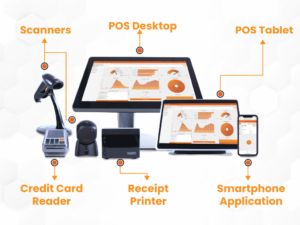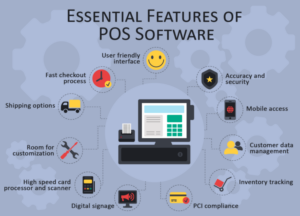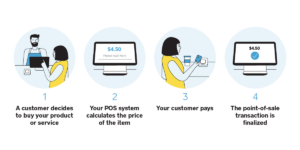Gone are the days of clunky cash registers and mountains of paper receipts. In today’s digital age, businesses of all sizes are embracing a more streamlined and efficient approach to point-of-sale (POS) systems – the Electronic Point of Sale (EPOS) system. But what exactly is an EPOS system, and how can it revolutionize your checkout process? Buckle up, because we’re diving deep into the world of EPOS, exploring its functionalities, benefits, and how it can empower your business for success in 2024 and beyond.
What is an EPOS system?
An EPOS system is a sophisticated software solution that replaces traditional cash registers. It goes beyond processing transactions to encompass inventory management, customer relationship management (CRM), and accounting functions.
EPOS system: Hardware, software, and payment powerhouse
An EPOS system is essentially a digital hub that integrates various components to transform your checkout experience. Here’s a breakdown of the key elements:

Hardware: This encompasses the physical equipment you interact with during a sale. It might include a touch-screen terminal, barcode scanner, receipt printer, and cash drawer. Modern EPOS systems can even integrate with sleek tablet setups, offering a mobile and user-friendly experience.

Software: The brain behind the operation! EPOS software is the heart of the system, managing transactions, recording sales data, and providing valuable insights. It allows you to create product catalogs, manage inventory, track customer information, and generate reports – all in one central location.
Payment processing: EPOS systems seamlessly integrate with various payment gateways, allowing you to accept all major credit cards, debit cards, contactless payments, and even mobile wallets like Apple Pay and Google Pay. This flexibility caters to a wider customer base and streamlines the checkout process.
How EPOS systems work

Now that you understand the building blocks, let’s see how an EPOS system works in action:
- Customer makes a purchase: A customer selects their desired items and approaches the checkout counter.
- Scan and Ring Up: The cashier scans the product barcodes using a barcode scanner, which automatically retrieves product information and pricing from the EPOS software.
- Payment Processing: The customer chooses their preferred payment method, and the EPOS system securely processes the transaction through an integrated payment gateway.
- Receipt Generation: A digital or printed receipt is generated, reflecting the purchase details and potentially offering promotions or loyalty program rewards.
- Data Collection: Behind the scenes, the EPOS system records the transaction data, including product details, quantities sold, and payment methods used.
This is just the tip of the iceberg. Modern EPOS systems offer a number of functionalities that extend far beyond basic checkout:
Inventory management: Track inventory levels in real-time, automatically trigger reorders when stock dips low, and avoid stockouts.
Sales reporting and analytics: Gain valuable insights into your sales performance, identify top-selling products, and make data-driven decisions to optimize your business strategy.
Customer management: Create customer profiles, track purchase history, and offer personalized promotions or loyalty programs to foster customer engagement.
Improved efficiency: Streamline checkout processes, reduce waiting times, and improve customer satisfaction.
Cloud-Based flexibility: Access your EPOS system and data from anywhere with an internet connection, offering greater mobility and scalability.
Why choose an EPOS system in 2024?
In today’s competitive retail landscape, staying ahead of the curve is crucial. Here’s how an EPOS system can empower your business:
Enhanced customer experience: Offer faster checkouts, multiple payment options, and personalized touches to keep customers coming back for more.
Reduced costs: Minimize operational costs, improve inventory management, and make better business decisions with data-driven insights.
Increased efficiency: Streamline workflows, improve employee productivity, and gain valuable time to focus on other areas of your business.
Data-Driven decisions: Gain real-time insights into sales trends, customer behavior, and inventory levels to adapt your approach and optimize performance.
Scalability and growth: EPOS systems are scalable to your business needs, allowing you to add features and functionality as your business grows.
Real-world success stories: EPOS systems in action
Let’s see how EPOS systems have transformed businesses across industries:
Coffee shop revival: Reduced wait times, increased average transaction value, and expanded online ordering with an EPOS system.
Restaurant efficiency: Optimized table turnover, minimized food waste, and improved customer satisfaction through EPOS implementation.
Retail revolution: Reduced stockouts, boosted sales, and launched a successful online store with the help of an EPOS system.
Is an EPOS system right for your business?
If you’re looking to streamline operations, gain valuable business insights, and enhance customer experience, an EPOS system is a worthwhile investment. By automating tasks, improving efficiency, and providing real-time data, an EPOS system empowers businesses of all sizes to make informed decisions, reduce costs, and achieve sustainable growth. Take the first step towards a more efficient future and discover the power of an EPOS system for yourself.
The future is EPOS
Whether you’re a small boutique or a large retail chain, an EPOS system can be a game-changer. With its ability to streamline operations, improve customer experience, and unlock valuable data, EPOS paves the way for a more efficient, profitable, and customer-centric future for your business.

